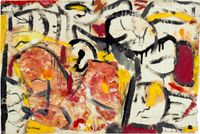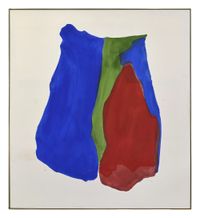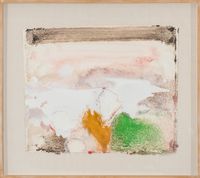Helen Frankenthaler is recognised as one of the great American artists of the 20th century. A member of the second generation of postwar American abstract painters, her soak-stain technique, which involved allowing thinned paint to seep into the fabric of the canvas, paved the way for Colour-Field painting. Her impact on contemporary art continues to resonate today.
Read MoreBorn into a respected New York family, Frankenthaler studied with painter Rufino Tamayo before attending Bennington College in Vermont, where she learned about significant contemporary American painters from artist Paul Feeley. Upon graduating in 1949, Frankenthaler moved to Provincetown, Massachusetts, to study with abstract painter Hans Hofmann.
In the 1950s, Helen Frankenthaler developed an innovative approach to abstraction by soaking and staining the canvas with thinned paint.
Frankenthaler began to exhibit in 1950.
Beach (1950), an abstract painting made using oil paint, sand, and coffee grounds, was featured in the group exhibition Fifteen Unknowns: Selected by Artists of the Kootz Gallery at the Kootz Gallery in New York.
Frankenthaler held her first solo exhibition at New York's Tibor de Nagy Gallery in 1951; that year, her early paintings were also shown in 9th St. Exhibition of Painting and Sculpture at 60 East 9th Street, a seminal exhibition that brought Abstract Expressionism to the fore of American post-war art. Among the included artists were Philip Guston, Franz Kline, Lee Krasner, Elaine de Kooning, Joan Mitchell, and Barnett Newman.
The year 1951 also saw Frankenthaler initiate a new direction for abstract painting. After attending an exhibition of Jackson Pollock's works, she was inspired to paint with her canvases on the floor—instead of throwing paint, however, the artist developed her own, idiosyncratic way of pouring paint onto unprimed canvas and soaking the fabric.
Frankenthaler's soak-stain technique led to one of her most influential works, Mountains and Sea (1952). The painting evokes the landscape through soft, tinted fields of blue and green surrounding red in the centre. The new kind of flatness in her work, achieved by allowing thinned paint to fuse with the fabric of the canvas, soon prompted Frankenthaler's contemporaries, including Kenneth Noland and Morris Louis, to develop Colour Field paintings.
During the following decades, Frankenthaler examined lines and their relationship with shape. Bold colours and hard-edged forms in blue, red, green, and yellow emerge in Italian Beach (1960). The 1960s also saw the artist engage with large expanses of colour in works such as The Bay (1963) and Indian Summer (1967). Frankenthaler also shifted to diluted acrylic paint from thinned oils, a development she made together with artist and her husband at the time, Robert Motherwell.
Helen Frankenthaler's woodcut prints are also renowned, through which she explored the various methods of applying colour and engaging the surface.
Cameo (1980), made from eight colour woodcuts, depicts a washed-out field of blue and purple with marks created with sandpaper and dentist drills. The triptych Madame Butterfly (2000) was printed from 102 colour woodcuts and 46 woodblocks, and captures the lyrical sensibilities found across Frankenthaler's paintings and works on paper.
Frankenthaler's work has been the subject of numerous monographs, illustrated volumes, and essays, including The heroine Paint: After Frankenthaler (2015); Line into Color, Color into Line: Helen Frankenthaler, Paintings 1962—1987 (2017); and Imagining Landscapes: Paintings by Helen Frankenthaler, 1952—1976 (2021). In 2021, art historian and professor Alexander Nemerov published a biography of the artist, titled Fierce Poise: Helen Frankenthaler and 1950s New York.
During her lifetime, Frankenthaler also contributed to contemporary American art by serving as a member of the American Academy of Arts and Letters (1974—2011) and the National Council on the Arts of the National Endowments for the Arts (1985—1992), among other posts. The Helen Frankenthaler Foundation, which was established by the artist, has been active since 2013.
The Foundation, in particular, is committed to supporting educational programmes of visual arts and addressing social and environmental concerns, with recent grants including the Frankenthaler Prints Initiative (2018); Helen Frankenthaler Foundation COVID-19 Relief Effort (2020); and Frankenthaler Climate Initiative (2021).
Helen Frankenthaler received international recognition early on, representing the United States at the 33rd Venice Biennale alongside Ellsworth Kelly, Roy Lichtenstein, and Jules Olitski in 1966.
Retrospective of Paintings, her major solo exhibition at the Whitney Museum of American Art, New York in 1969 went on an international tour to the Whitechapel Gallery, London; Orangerie Herrenhausen, Hanover; and Berlin Kongresshalle.
Frankenthaler's artworks continue to be exhibited worldwide, with recent solo exhibitions including Helen Frankenthaler: Radical Beauty, Dulwich Picture Gallery, London (2021); Imagining Landscapes: Paintings by Helen Frankenthaler, 1952—1976, Gagosian, London (2021); Helen Frankenthaler, Tate Modern, London (2019); PITTURA.PANORAMA: Paintings by Helen Frankenthaler, 1952—1992, Museo di Palazzo Grimani, Venice (2019); Abstract Climates: Helen Frankenthaler in Provincetown, Provincetown Art Association and Museum (2018); Helen Frankenthaler, Paintings: 1961—1973, John Berggruen Gallery, San Francisco (2010); and Against the Grain: the Woodcuts of Helen Frankenthaler, National Gallery of Australia, Canberra (2005).
Selected group exhibitions include Contemporary Art: Five Positions, Museum of Fine Arts, Boston (2019); Epic Abstractions: Pollock to Herrera, Metropolitan Museum of Art, New York (2018); Peindre la nuit, Centre Pompidou-Metz, France (2018); Abstract Expressionism, Guggenheim Bilbao, Spain (2017); Making Space: Women Artists and Postwar Abstraction, Museum of Modern Art, New York (2017); The New York School, 1969: Henry Gelzahler at the Metropolitan Museum of Art, Paul Kasmin Gallery, New York (2015); and Making Painting: Helen Frankenthaler and JMW Turner, Turner Contemporary, Margate (2014).
Sherry Paik | Ocula | 2021






